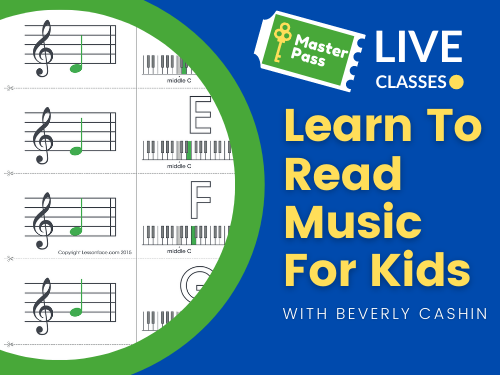7 Tips For Teaching Music To Kids

Teaching kids music as a parent or an educator is not always easy! Every child is different, and learning how to read and play music can be hard. Music is like any other language; there are a lot of small parts to keep track of, not to mention short attention spans to manage.
Whether you’re teaching your child how to read music at home, supplementing with group classes, or enrolling in live, online private lessons, we often get stumped as educators when one approach doesn’t work. Fortunately, there are a number of ways we can make the process of learning music more fun and engaging for kids, which in turns makes teaching music more enjoyable for us!
1. Choose Fun Music
Work with music that appeals to your child or students. Ask them their favorite songs! There are a lot of wonderful resources these days to find simplified versions of songs, or challenge yourself to teach a song by ear. I find that my students make the most progress when they work on versions of the songs that they love. This is music that they want to learn, and the effort that goes into reading or practicing these pieces doesn’t feel like effort in the same way as a curriculum or lesson assignments do.
Whether you’re working from simplified sheet music or playing a song by ear together as a reward for making it through lesson book assignments, working with familiar music provides extra motivation for young learners!
2. Turn It Into A Game
If learning to read music becomes an active playtime, you are doing amazing things for your child’s love of learning. When I have students who are losing focus during a lesson, I find it’s helpful to switch gears for a moment, rather than continuing exactly with what we were working on.
For example, if we’re writing down note names for a piece of music, I’ll turn it into a “race” to see if the student or I can write down note names faster and more accurately than the other. (Hint: I don’t usually win for some reason!)
To keep things non-competitive, try adding in a fun activity while working on reading music. For example, sometimes I’ll draw a music monster with my younger students. After a certain number of correct notes in a row, each person takes a turn adding one element to our monster. We’ll start with one arm or leg at a time and end with spots, spines, teeth or whatever else can be imagined!
The resulting drawing is fun and silly, and we can explore how the music monster might sound once the exercise is finished. Interspersing creative mini games into a lesson can do a lot to hold a child’s attention.
3. Add Movement
Not only does physical movement encourage fine motor control, but we all learn in different ways. Embodying staccato or shorter notes with short, quick movements, or showing legato and longer notes with smooth, connected movements can help capture these ideas and make them “click” for a student.
Try moving through rhythms together, use the solfege hand signs, or raise your hands higher and lower to show different pitch levels. These all can help cement musical ideas in ways that learning from a text won’t.
Try marching together for quarter notes; keep a steady rhythm and count repeated measures in 4/4 aloud. Run in place to eighth notes counting “1 and 2 and 3 and 4 and” with a step for every subdivision of the beat. Clap rhythms together while counting aloud.
For an instrument like piano where hands might have separate rhythms, I like to help my students warm-up with a “talking hand” and a “high five” hand exercise. One hand will be “talking” at a faster rhythm, opening and closing steadily. The other hand gives high fives to the teacher, a classmate, or even an imaginary friend.
Fortunately for educators and parents, physical movement can be added to any musical concept with a little imagination!
4. Give Them Responsibility
Some students do particularly well when challenged to teach or explain something to their pet, sibling, friend, or even a toy. Asking students to put something in their own words helps them further solidify concepts and gives you a chance to see how well they’re understanding what you’re working on.
Encourage them to talk through how to play a piece of music, or how to do an exercise. Ask them what musical terms mean and listen to their explanations. If you’d like clarity on an explanation, ask them questions as though you are the “student” they’re talking to!
5. Praise Their Achievements 
Find what’s going well in their studies and praise that. Confidence is a big part of becoming a better musician. Confidence gives us the courage to try new things or look at things in a new way to improve our musicianship or technique.
It’s important to focus on success and not failures. It’s too easy to become paralyzed by the fear of doing something “wrong” in music. Unfortunately, this can stunt our growth as musicians. There will be right answers to a note reading exercise, and a better way to play a piece, but focusing exclusively on what’s going wrong does more harm than good.
Before offering corrections, find something that went well — good rhythm, accurate note reading, playing the whole exercise without stopping, the student self-correcting, etc — and praise that first. This keeps the lesson in a better place mentally for your learner as you work on weaker areas.
6. Free Their Creativity
Great news! We don’t always have to play what’s on the page or do exactly as the exercise worksheet says! To really maximize your students’ understanding of music, turn it into something enjoyable. Music can simply be all about expression, creativity, and experimentation.
Take a concept you’re working on, and turn it into a creative activity. If you’re working on half notes and quarter notes, ask them to make up their own pattern of half notes and quarter notes with any notes they want. Spell simple words in notes, try creating different moods in music.
Try writing “patterns” or short songs: Can they make up a theme song for their favorite character? A happy song that’s fast? A sad song that’s slow? Or a scary theme with random notes? Can they create a pattern of notes they like using long and short notes? Maybe they know a silly word and you can make up a silly song together! This kind of creative play is about leading and suggesting, then working with the ideas your child gives you.
Tip: To encourage experimentation, let your students or child know that if something sounds like a mistake the first time, repeat it exactly the same way, and it won’t sound like a mistake the second time. Once may sound like a mistake, but twice sounds like purpose!
These kinds of activities are wonderful for foundational ear and rhythm training. You’re also teaching your child to freely create without judging themself; and this is the only way that true creativity happens. The creative mind is a very different place from self-evaluation or self-judgement!
7. It Takes A Little Patience
It’s okay to ask for help! If you’re stuck for ideas on helping your child improve their musicality or just want more ideas to help teach them on your own, talk to a teacher. Be open to what works best for your child’s learning style, whether that’s fun group classes with their peers around, or live, online private lessons if one-to-one instruction fits them better.
Ultimately, perseverance combined with a little creativity makes it possible for anyone to learn to read music! Try some of these ideas with your young learners; you’ll be enriching their lives and helping their personal development by doing so.






